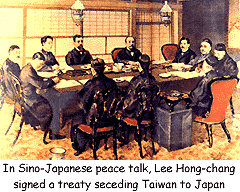 |
A Brief
History of Taiwan |
After prevailing
on the mainland, the Ching dynasty conquered Taiwan in
1683. Thereafter Taiwan became a territorial part of the
Chinese empire. Despite such, the Manchu control of
Taiwan was largely focused on preventing Taiwan from
becoming a base of resistance or as a haven for Chinese
criminals. As a result, various restrictions were placed
on the migration of Chinese to Taiwan, and Chinese were
banned from developing Taiwan's mountainous regions,
with development restricted to the Western coastline.
Government administration functioned within this
boundary, while everything beyond the limits was
considered foreign. Therefore, before the mid-19th
century, the Ching dynasty was only in control of the
Western plains, and the ruling capability of
administrative institutions was quite weak.
As the Manchus weren't overly eager to
rule Taiwan and their ability to rule was limited, Chinese along the mainland's
southeastern coast ignored various restrictions and migrated to Taiwan, seeking
a world of new opportunity. This created a strong dynamic on Taiwan in contrast
to the apathy of the Manchus. These new migrants brought with them techniques
and culture from their home villages and created villages among indigenous
tribes in the plains. They either rented land from or forcibly occupied
aboriginal land, and intermarried with the indigenous peoples. Over a period of
roughly 200 years of this interaction, most aborigines of the plains became
integrated with the immigrants from China. Only a few retain their indigenous
language and culture to this very day.
As a result of the weak government,
immigrants were forced to use their own means to protect themselves, which
sparked the creation of social regulations and an arbitration system. Villages
and townships entered into mutual protection alliances, and society in general
became armed. Some remnants of this are still seen in Taiwan society. For
example the sacrificial rites seen in folk religious activities often can be
traced back tot the protection alliances of times past.
In the second half of the 19th century,
Western colonial powers again extended their influence to the Far East. In 1860,
the Chang dynasty opened the ports of Tamsui in northern Taiwan and Kaoshiung in
southern Taiwan to foreign trade and allowed missionaries to come to Taiwan. The roughly 150-year break in contact with the West ended, and tea and
camphor became emerging industries. This sparked rapid development in the hills
of Taoyuan, Hsinchu, and Miaoli In 1874, Japan sent troops to Taiwan in response
to the killing of an Okinawan living outside the borders of government control
in Southern Taiwan. This spurred the Ching Dynasty to include areas outside the
borders under its rule, and it enabled legal development in the foothills. In
1884, the Sino-French War rippled through Taiwan when the French army occupied
northern Taiwan and its navy blockaded Taiwan's ports. In response to the
foreign invasion, the Ching dynasty made Taiwan a province and increased the
island's defensive fortifications. However, the Sino-Japanese War of 1894 set
the stage for Taiwan to be ceded to Japan the following year under the terms of
the Treaty of Shimonoseki.
Taiwan. The roughly 150-year break in contact with the West ended, and tea and
camphor became emerging industries. This sparked rapid development in the hills
of Taoyuan, Hsinchu, and Miaoli In 1874, Japan sent troops to Taiwan in response
to the killing of an Okinawan living outside the borders of government control
in Southern Taiwan. This spurred the Ching Dynasty to include areas outside the
borders under its rule, and it enabled legal development in the foothills. In
1884, the Sino-French War rippled through Taiwan when the French army occupied
northern Taiwan and its navy blockaded Taiwan's ports. In response to the
foreign invasion, the Ching dynasty made Taiwan a province and increased the
island's defensive fortifications. However, the Sino-Japanese War of 1894 set
the stage for Taiwan to be ceded to Japan the following year under the terms of
the Treaty of Shimonoseki.
Previous Page |
Next Page
|
 |

 Taiwan. The roughly 150-year break in contact with the West ended, and tea and
camphor became emerging industries. This sparked rapid development in the hills
of Taoyuan, Hsinchu, and Miaoli In 1874, Japan sent troops to Taiwan in response
to the killing of an Okinawan living outside the borders of government control
in Southern Taiwan. This spurred the Ching Dynasty to include areas outside the
borders under its rule, and it enabled legal development in the foothills. In
1884, the Sino-French War rippled through Taiwan when the French army occupied
northern Taiwan and its navy blockaded Taiwan's ports. In response to the
foreign invasion, the Ching dynasty made Taiwan a province and increased the
island's defensive fortifications. However, the Sino-Japanese War of 1894 set
the stage for Taiwan to be ceded to Japan the following year under the terms of
the Treaty of Shimonoseki.
Taiwan. The roughly 150-year break in contact with the West ended, and tea and
camphor became emerging industries. This sparked rapid development in the hills
of Taoyuan, Hsinchu, and Miaoli In 1874, Japan sent troops to Taiwan in response
to the killing of an Okinawan living outside the borders of government control
in Southern Taiwan. This spurred the Ching Dynasty to include areas outside the
borders under its rule, and it enabled legal development in the foothills. In
1884, the Sino-French War rippled through Taiwan when the French army occupied
northern Taiwan and its navy blockaded Taiwan's ports. In response to the
foreign invasion, the Ching dynasty made Taiwan a province and increased the
island's defensive fortifications. However, the Sino-Japanese War of 1894 set
the stage for Taiwan to be ceded to Japan the following year under the terms of
the Treaty of Shimonoseki.